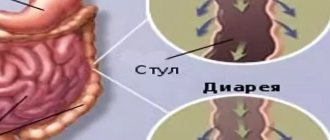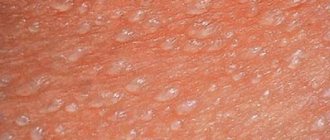Many people are embarrassed to talk about such a delicate topic as stool color, even at a doctor’s appointment. But false modesty often leads to serious health problems. For example, yellow feces in adults often indicate problems with the body. If this symptom persists for a long time, it is recommended to consult a doctor and undergo a full medical examination.
Changes in stool color often indicate problems in the body.
What gives color to stool
In fact, 75 percent of what we see in the toilet is water. The remaining share is distributed between:
- Remaining fat.
- Bilirubin.
- Protein inclusions.
- Mineral salts.
- Leftover undigested food.
- Mucus, which is produced by the digestive organs.
- Bacteria.
What causes mucus in stool: causes and treatment of diseases
Bile and bilirubin are the main coloring agents in stool that give it its brown color. But when the percentage of these components changes, yellow stool, orange feces or other shades appear. Bilirubin is formed as a result of the breakdown of red blood cells, which is why it has such a rich pigment. Many organs take part in the process of formation of digestive waste, the work of each of which is very important. This is why orange or yellowish stool may indicate a disease of a particular organ.
https://youtu.be/JJDtfpIJ_ro
Symptoms
Yellow stool is the most important signal that there are problems with internal organs. If you ignore such external manifestations, the patient’s general condition can significantly worsen. That is why it is extremely important to promptly contact a specialist for qualified help.
If yellow feces are detected in an adult, then a competent specialist is obliged to provide an individual approach. Therapy is usually associated with the use of pharmacological drugs; if they are correctly selected, then yellow stool will no longer be a problem.
So, treatment can be aimed at solving the following problems:
- Normalization of digestion;
- restoration of pancreatic and liver function;
- normalizing metabolism through a strict diet;
- activation of the pancreas.
Orange stool can often indicate that there are serious pathologies in the gastrointestinal tract. Therefore, you should not hesitate; it is best to contact a qualified specialist who will correct the situation.
If the case is very advanced, that is, the patient has not paid attention to the fact that the stool is orange for a long time, surgical intervention may be required. Of course, in this case, other symptoms will be present - nausea, vomiting, pain in the epigastric area, etc.
But it is worth noting that most diseases that cause orange stool can be cured with correctly selected therapeutic treatment:
- A course of specially selected medications;
- procedures;
- strict diet.
Orange feces often indicate diseases of the pancreas. For example, if there is more fatty food in the diet and the body reacts this way, this indicates that the body does not secrete enough enzymes to break down fats.
In this case, yellow mucus may be present in the stool of an adult. In any case, only a doctor can make a correct diagnosis and prescribe effective treatment. Therefore, there is no need to delay your visit.
You may also be interested in
- What are the reasons for diarrhea and stomach cramps, and how to deal with it?
- Why does stool become dark in color, and what to do?
- How you can save money on the treatment of digestive disorders - we are looking for cheaper Linex analogues
- Fever without signs of a cold - causes and dangers
- What does diarrhea and nausea mean in an adult without fever and what to do about it
If the problem is short-term, it may be caused by poor diet. In this case, you should simply refuse junk food.
However, persistence of lack of stool coloration for several days should be a signal to immediately visit a doctor, especially if it is accompanied by symptoms such as:
- acute abdominal pain;
- heat;
- sudden weight loss;
- nausea, vomiting;
- sour belching;
- diarrhea.
Such manifestations are signs of serious diseases and, if not treated in a timely manner, can lead to irreversible consequences.
If, in addition to lightening the stool, you feel unwell and a deterioration in your general condition, you should seek medical advice. Especially if you eat, the malaise does not go away within a day. Symptoms to watch out for:
- persistent increase in temperature;
- stool disorder;
- nausea, vomiting;
- pain in the abdomen, left hypochondrium, girdle pain;
- yellowed sclera of the eyes and skin;
- lack of appetite;
- sudden weight loss;
- dark urine;
- flatulence, abdominal enlargement;
- stool with mucus.
If there are at least two additional signs with light-colored stool, it is necessary to undergo a medical examination to determine the diagnosis. With some problems, for example, with advanced pancreatitis, the count is not days, but hours. Be attentive to symptoms and do not ignore serious ailments.
In adults, yellow feces are often caused by poor diet. However, in some cases, a symptom indicates the course of a disease in the body. In this case, it is necessary to establish the root cause of the violation as early as possible. This can be done through comprehensive diagnostics.
It is important to pay attention to general well-being, additional symptoms and localization of signs. Yellow feces in an adult are a clear deviation from the norm. Feces reflect the state of the digestive system, so it is strictly forbidden to ignore such a sign.
Otherwise, there is a risk of serious complications.
The color of stool depends on the functioning of the digestive system
An adult's feces can have different shades. Sometimes the condition does not require treatment and is a normal symptom.
| Dark brown color | Indicates a rich and varied diet with all the necessary components present |
| Orange color | Indicates an excess of carrots and pumpkin in the diet. Also capable of signaling a person’s adherence to a vegetarian diet |
| Light yellow color | Light yellow stool in an adult may indicate that the person is following a milk-based diet |
| Black color | Black feces indicate the presence of excessive amounts of meat in the diet |
Yellow stool is normal if the symptom occurs after a change in diet. The stool takes on a normal color within a few days. There are no additional symptoms. The symptom also appears when taking certain medications.
Yellow stool can be observed in people who are constantly under stress
Yellow stools may indicate nervous tension. Feces change color after a strong emotional outburst, which can be associated with both positive and negative events. An adult's feces will recover within a few days.
An adult's stool may turn yellow when consuming the following foods:
- citrus;
- carrot;
- melon;
- apples;
If you eat a lot of carrots, the color of your stool may change.
- dairy products;
- peas;
- baking for individuals with gluten intolerance.
The listed products provoke changes in stool only if they were consumed in excessive quantities. Among the medications, the following medications can cause yellowing of stool:
- Magnesium sulfite;
- Senade;
- contraceptive medications;
- some anti-inflammatory drugs.
Often the appearance of yellow stool can be explained by the excessively rapid movement of food through the gastrointestinal tract. The condition is usually not dangerous.
Stool turns yellow when taking medications, for example, Senade
The patient should closely monitor his well-being. Additional symptoms may indicate the course of the disease and dysfunction of certain organs. With yellow stool, it is difficult to establish the true cause of the deviation. A sign in an adult may indicate:
- viral and bacterial infections;
- food intoxication;
- infection with staphylococcus;
- helminthiasis;
- fungal disease;
- gastritis;
- inflammatory process in the pancreas;
- colitis;
- liver diseases;
- abnormalities in the functioning of the thyroid gland;
- intestinal disorders;
- hormonal disorders.
All of these deviations may have a similar clinical picture. It is for this reason that the patient needs a comprehensive diagnosis.
If you notice yellow stool, check your liver
Diseases of the pancreas are one of the most common root causes of yellow stools.
In this case, there is a lack of enzymes in the adult’s body, which is required for the complete digestion of food. The walls of the small intestine are injured.
An inflammatory process is formed. Patients often experience intense diarrhea.
If you have diarrhea, you may have problems with your pancreas.
The skin turns pale and becomes dry. Skin rashes may occur. At night, visual acuity is greatly reduced. The body is exhausted and inflammation of the organs of vision occurs.
Another common root cause of yellow stool color change is diseases of the small intestine. In this case, the body cannot digest food normally.
Vitamins and microelements stop being absorbed. In adults, fecal matter moves faster through the gastrointestinal tract. The number of pathogenic microorganisms is increasing.
The patient begins to complain of bloating, excessive gas formation and abdominal pain.
Sometimes the cause may be in the small intestine
Yellow stool in an adult requires a comprehensive diagnosis. The patient should urgently visit a doctor, especially if there are a huge number of additional symptoms and the deviation is observed for a long period of time.
If a pathological symptom is present, the possible causes of its occurrence should be analyzed. Pay attention to additional symptoms. In addition, you need to exclude from your diet foods that can cause yellowing of stool. Also, if possible, stop taking medications.
If the patient has not found the cause of the deviation, then he needs to go to the hospital. In a medical institution, an adult will be given a referral to:
- bacteriological examination of stool;
- Ultrasound;
- generalized and biochemical blood test.
Based on the examination results, the doctor will prescribe treatment.
Symptoms and signs of light-colored stool:
- Nausea and vomiting
- Yellowing of the skin
- Bloating
- Abdominal pain
- Temperatures above 39 degrees
- Loose stools containing undigested food
- Weight loss
- Flatulence
- Diarrhea
Problems with the digestive tract can cause pale stool with a foul odor. Problems may be accompanied by diarrhea (frequent trips to the toilet with diarrhea).
If the stench and diarrhea do not go away, then there may be problems with the gallbladder.
With impurities
If the light color of the stool is accompanied by grains, then there is nothing wrong with that. These are leftover food that have not had time to be digested. If the impurity is in the form of worms, then these are parasites and you should consult a doctor.
With white slime
In what cases is yellow feces in an adult not a reason to worry?
There are several coloring options without side processes in the body:
- The dark brown color may be the result of a rich, varied diet with many ingredients.
- Orange feces are formed as a result of eating large amounts of carrots and pumpkin. Orange stool can also appear during a vegetarian diet.
- Light yellow stool may appear when a person is on a dairy diet.
- Almost black excrement is formed when eating large quantities of meat products.
It is better not to ignore other changes or the appearance of stool with mucus, but to consult a doctor. It should be noted that yellow mucus in the stool of an adult most often appears due to poor functioning of the gallbladder, which means that the process of digesting food takes place with an insufficient amount of enzymes.
Important. If changes in the color of the stool are associated with the intake of certain highly pigmented foods, then literally within 48 hours after stopping these foods, the excrement should turn brown. If this does not happen, then you won’t be able to figure it out without a specialist.
Treatment
Treatment of yellow stool begins with diet. If the diet does not help, you need to add medications.
Eliminate coloring foods (carrots, milk, etc.) from your diet. If after 1-2 days the stool begins to return a brown tint, everything is fine.
If you are sick and take medications, consult your doctor about possible side effects.
If a change in stool color is accompanied by abdominal pain, diarrhea, loss of appetite, weight loss, fever and other negative conditions, consult a doctor for a diagnosis and treatment.
What disorders can cause yellowish or orange stool?
If you have practically ruled out the influence of food on the coloring of stool, then you need to become familiar with diseases that may be accompanied by a change in the color of stool in an adult. And this will allow you to quickly respond to the development of the disease and receive qualified help in the early stages of the disease.
Pathological changes in the functioning of the liver and gallbladder
In this case, the light yellow color of stool appears due to the fact that these organs do not produce the enzymes necessary for digestion. This prevents the body from absorbing nutrients from foods. This can occur when liver cells are destroyed and gallstones form. With this clinical picture, yellowing of the stool occurs, and the person begins to experience pain in the locations of the organs.
Pancreatic disorders
The pancreas takes an active part in the digestion process, so any disorders and diseases lead to bad consequences for the whole body. Light yellow stool can be an indicator that a person has pancreatitis, cystic fibrosis, or gland cancer. This phenomenon may also accompany blockage of the ducts. Anything that prevents the gland enzymes from entering the stomach and maximally breaking down all food products leads to changes in the color of feces. Sometimes you can even see foam in the toilet bowl, because there can be a lot of unprocessed fat left in the excrement.
Celiac disease
When asking why stool is light yellow in color, it is worth remembering that the foods we eat often contain gluten. Its high concentration is observed in barley, rye and wheat grains. Excessive content of this substance in the body leads to a decrease in the immune function of the body and enveloping the walls of the stomach with gluten, and this does not allow nutrients to be absorbed. In this case, a number of other symptoms are observed:
- Nausea.
- Bowel problems (constipation or diarrhea).
- Fatigue.
- Unreasonable headache.
- Skin rash.
- Excessive formation of gases.
- Reduced bone density.
If this problem is identified quickly, then complex therapy will not be needed - simply a dietary diet will be selected. But a complex form of the disease will require thorough long-term treatment.
Gilbert's syndrome
This disease is genetic and its essence lies in the body’s excessive production of too much bilirubin, which causes the orange color of the stool. There is no specific therapy for this disease, however, specialists can constantly monitor the functioning of the digestive system and prevent the development of associated disorders. In this case, the child has orange stools almost from infancy.
Important. The cause of yellow and orange stools can be not only pathological changes in the digestive system, but also various intestinal infections, which are dangerous due to the rapid dynamics of damage to the body.
Infectious disease giardiasis
This disease is characterized by the colonization of the gastrointestinal tract by parasites. They penetrate with food and drink. In this case, there may be yellow stool or orange stool, and in addition to this there is another group of disorders:
- Vomit.
- Nausea.
- Diarrhea with a strong unpleasant odor.
- Skin rashes.
- Severe headaches.
- Sudden weight loss with a normal diet.
Giardiasis is detected by examining stool in the laboratory. Treatment of the disease is often carried out by taking antibiotics for several weeks. It is extremely rare that the disease becomes chronic.
What does yellow stool without pain indicate?
Such changes occur most often when consuming certain foods. Among them:
- apples, carrots, oranges, dried apricots, melon;
- milk and dairy products;
- beans, peas.
Significant changes in the color of stool also provoke:
- inability to digest gluten;
- hormonal disorders;
- stress;
- depression;
- taking certain medications - antibiotics, vitamins, contraceptives.
In order to exclude possible serious diseases, it is advisable to undergo an examination to identify the true causes of changes in the color of stool.
Should I worry about yellowing stool during pregnancy?
While carrying a child, a woman’s body works at maximum speed, and all hidden resources are activated. Such intensive work leads to the fact that each organ experiences great stress. The digestive system undergoes a particularly difficult period. This is why there can be yellow stool during pregnancy, as well as other colors, without signaling any problems in the body. However, there is a group of problems that may be accompanied by yellowness of feces during pregnancy:
- Disorders of the pancreas.
- Liver disorders.
- Eating too fatty foods that interfere with the proper functioning of the digestive system.
All this is easily diagnosed and there are therapeutic programs developed specifically for pregnant girls. The main thing is to point out your problem to your doctor in a timely manner. Don’t be alarmed by changes in your stool, but keep an eye on them, and don’t hesitate to go to a specialist with the problem that’s bothering you. A timely reaction to any disorders in the body will allow you to get rid of them quickly and painlessly. If you found this article useful, please share it with other readers and leave a review. Sometimes this information can help someone stay healthy.
Digestive difficulties: causes and treatment
If, along with the appearance of yellow stool, you have a stomach ache, or have complaints such as flatulence (boiling in the intestines), diarrhea or difficulty defecating, poor appetite, bitterness in the mouth, then this means the presence of serious disorders. It is especially dangerous if the pain is paroxysmal. Often these symptoms occur after eating fatty foods and alcohol.
A number of possible reasons for such complaints:
- hepatitis of any origin;
- fermentative dyspepsia;
- gallbladder diseases;
- compression of the bile duct,
- biliary dyskinesia;
- pancreas pathology;
- chronic constipation;
- metabolic diseases.
The liver is considered the laboratory of our body. It not only synthesizes various necessary substances, but also neutralizes toxic toxins and substances (for example, alcohol).
When it is damaged or overloaded, one or several functions may suffer.
Problems with the liver disrupt the processing of bilirubin, and it enters the intestines unprocessed. Such bilirubin is a bad dye, so light yellow, loose feces can often be released after alcohol.
Poorly digested pale gray feces are a common occurrence in people who eat very fatty meat products (usually men) or starchy carbohydrate foods (usually women). This disorder is called dyspepsia. Putrefactive dyspepsia is a “failure” in the breakdown of proteins. Carbohydrates that have not undergone the necessary enzymatic treatment cause fermentative dyspepsia. Fermented or rotten substances are absorbed in the intestines and have a toxic effect on the entire body. The cause of this disorder may be associated with any digestive organ.
How to deal with the problem
What to do if the design of the chair has changed? If you feel normal and have no discomfort, it is enough to normalize your diet and stop taking medications. If after a few days the stool becomes normal in color, there is no cause for concern.
You will need urgent consultation with a specialist if the following accompanying symptoms appear:
- changes in mental and emotional background;
- causeless fainting;
- fever;
- abdominal pain accompanied by vomiting;
- shortness of breath;
- difficulty or painful urination;
- purulent stools.
Changes in the structure of stool can be caused by a number of reasons. Factors related to eating habits and taking specific medications during treatment are not alarming or life-threatening. But you should not lose sight of changes in stool, accompanied by painful sensations in the gastrointestinal tract and other organs.
The attending physician, who collects medical history data to determine the patient's condition, takes into account many factors. Age, appearance, well-being of the patient, presence or absence of pain - all these aspects are important details when diagnosing pathology.
p, blockquote 1,0,0,0,0 –>
p, blockquote 2,0,0,0,0 –>
When it comes to diseases of the gastrointestinal tract, the color, consistency, smell of stool, and the regularity with which a person defecates play an important role. In particular, the color of the stool can tell a lot about the condition of the intestines and other elements of the digestive system, the patient’s diet and other individual nuances.
p, blockquote 3,0,0,0,0 –>
Diagnosis of disorders
An examination of a patient with yellow diarrhea begins with an assessment of the clinical picture, clarification of complaints, dietary habits, nature of work, and medical history. During laboratory testing, in addition to general clinical blood and urine tests, a stool test is performed. When examining, pay attention to the consistency and shape, color and smell. Impurities of blood, mucus, and intestinal parasites are visually determined.
To determine the cause of diarrhea, it is necessary to study the microorganisms contained in the stool. According to microscopy, the presence of pathogenic microbes is determined. If pathogens are present, the infectious nature of the problem is established. To definitively identify pathogens and study their sensitivity to antibacterial drugs, microbes are placed in an environment in which they grow well. During bacteriological research, the properties of the pathogen are studied and the most effective therapeutic regimen is determined.
Prevention of diarrhea
In order for the body to fully recover, it is necessary to maintain proper nutrition. To maintain water balance, you should drink intensively for 14 days. To prevent diarrhea, it is recommended to maintain good personal hygiene. If a person has previously suffered from diarrhea, then probiotics are taken as a preventive measure. It is recommended to drink a decoction of St. John's wort or herbal tea.
Depending on the signs and changes in stool color, a person should pay close attention to their health. Stool mixed with secretions that were previously unnoticed can become a symptom of a serious illness. In most cases, the problem is considered to be yellow diarrhea with possible variations. A person needs to pay attention to additional symptoms. Sometimes this refers to the manifestation of adaptation of the body.
We recommend: What can cause diarrhea at 36 weeks of pregnancy and is it dangerous?
If the stool is light green
Light green stool can be caused by taking antibiotics. Due to specific processes that occur in the small intestine when taking these drugs, the excrement becomes light or dark green.
If the green tint of the stool is combined with other signs, such as fever, vomiting, nausea, then the cause of this phenomenon may be dysentery. Urgent medical attention is required.
Green stool may indicate ulcers and tumors in the gastrointestinal tract. Also, in combination with diarrhea and vomiting, this symptom indicates an intestinal infection.











